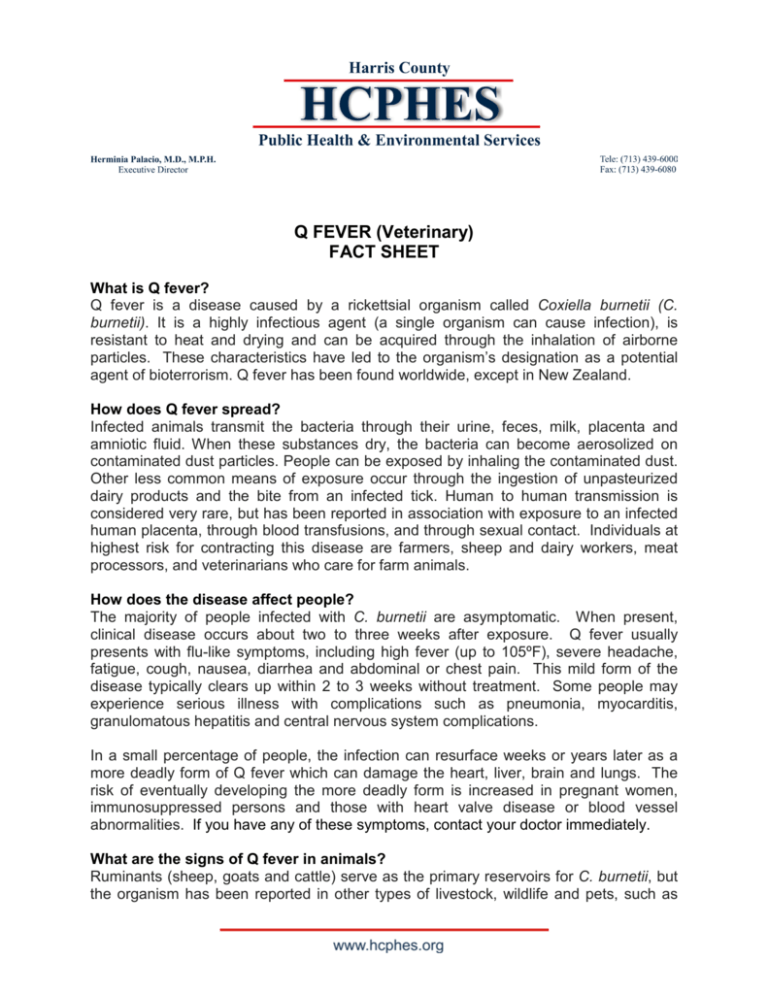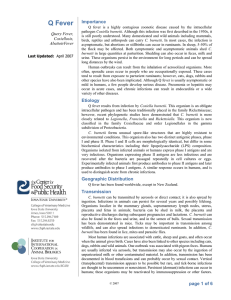Q FEVER (Veterinary) FACT SHEET
advertisement

Q FEVER (Veterinary) FACT SHEET What is Q fever? Q fever is a disease caused by a rickettsial organism called Coxiella burnetii (C. burnetii). It is a highly infectious agent (a single organism can cause infection), is resistant to heat and drying and can be acquired through the inhalation of airborne particles. These characteristics have led to the organism’s designation as a potential agent of bioterrorism. Q fever has been found worldwide, except in New Zealand. How does Q fever spread? Infected animals transmit the bacteria through their urine, feces, milk, placenta and amniotic fluid. When these substances dry, the bacteria can become aerosolized on contaminated dust particles. People can be exposed by inhaling the contaminated dust. Other less common means of exposure occur through the ingestion of unpasteurized dairy products and the bite from an infected tick. Human to human transmission is considered very rare, but has been reported in association with exposure to an infected human placenta, through blood transfusions, and through sexual contact. Individuals at highest risk for contracting this disease are farmers, sheep and dairy workers, meat processors, and veterinarians who care for farm animals. How does the disease affect people? The majority of people infected with C. burnetii are asymptomatic. When present, clinical disease occurs about two to three weeks after exposure. Q fever usually presents with flu-like symptoms, including high fever (up to 105ºF), severe headache, fatigue, cough, nausea, diarrhea and abdominal or chest pain. This mild form of the disease typically clears up within 2 to 3 weeks without treatment. Some people may experience serious illness with complications such as pneumonia, myocarditis, granulomatous hepatitis and central nervous system complications. In a small percentage of people, the infection can resurface weeks or years later as a more deadly form of Q fever which can damage the heart, liver, brain and lungs. The risk of eventually developing the more deadly form is increased in pregnant women, immunosuppressed persons and those with heart valve disease or blood vessel abnormalities. If you have any of these symptoms, contact your doctor immediately. What are the signs of Q fever in animals? Ruminants (sheep, goats and cattle) serve as the primary reservoirs for C. burnetii, but the organism has been reported in other types of livestock, wildlife and pets, such as cats, dogs and rabbits. While most animals are asymptomatic, infected animals may show anorexia, fever, respiratory signs, abortion and infertility. How can I prevent infection? Prevention of Q fever in animals can be difficult since infected animals often show no signs of infection. Additionally, the organism is very resistant to environmental and chemical factors and therefore can survive in the environment for several weeks. To help prevent the spread of the disease: • isolate newly purchased animals and animals that abort from the rest of the herd • burn or bury any potentially contaminated reproductive discharges, including placentas • contaminated equipment and surfaces should be cleaned thoroughly with soap and water and disinfected with a phenolic disinfectant (e.g. Lysol®) • use only pasteurized milk and milk products • avoid contact with animal products that may be infected (placenta, birth products, fetal membranes, and aborted fetuses of sheep, cattle, and goats) • wear appropriate personal protective clothing (PPE) when assisting in animal births, working in laboratories and handling carcasses in processing facilities. Additional PPE should be used when working with potentially contaminated dust or aerosols. • wash hands thoroughly after handling any animal or animal product that may be contaminated Where can I get more information on Q fever? www.cdc.gov www.dshs.state.tx.us www.cfsph.iastate.edu Source of Information Centers for Disease Control and Prevention (CDC) The Center for Food Security & Public Health Jan. 2013 VPH/OPI










